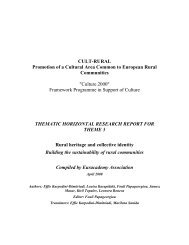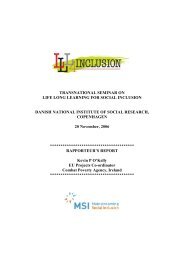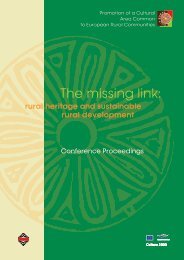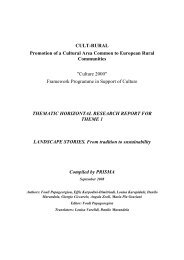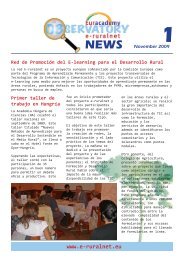ÐÐ¾Ð´Ð°Ñ Ð¿Ð¾ изложбаÑа - cult rural - Prisma
ÐÐ¾Ð´Ð°Ñ Ð¿Ð¾ изложбаÑа - cult rural - Prisma
ÐÐ¾Ð´Ð°Ñ Ð¿Ð¾ изложбаÑа - cult rural - Prisma
Create successful ePaper yourself
Turn your PDF publications into a flip-book with our unique Google optimized e-Paper software.
RITES OF PASSAGE<br />
SUMMER SOLSTICES FIRES AND FUTURE PREDICTIONS<br />
Rites of passage include customs and rituals that celebrate birth, initiation,<br />
marriage, death, many occurring in the annual liturgical calendar and most of,<br />
if not all, those of seasonal changes. To the latter belongs a well known Greek<br />
custom, that of Klidonas (“Soothsayer”).<br />
It is celebrated on 24th of June, the Feast day of Saint John the Baptist, marking<br />
the summer solstice, an astronomical phenomenon that impressed traditional<br />
people and led to many superstitions. St John’s day provides an opportunity to<br />
revive all the customs and practices of the summer solstice, when the inverse<br />
movement of the sun begins, that of decline, which six months later will lead to<br />
the winter solstice. Therefore, it is not strange that in almost the whole of Europe<br />
people celebrate the sun’s momentary victory by lighting up fires. These open air<br />
summer fi res have their counterparts in the winter fi res during Christmas.<br />
The summer solstice fi res, into which are thrown wreaths of flowers in many<br />
Greek regions (especially in May), are not only fi res for jubilation and purification,<br />
but also fi res for protection against misfortune, bad luck and illness, which,<br />
traditionally, man feared would happen due to the suns’ gradual decline. People<br />
usually jump over the fi res to dispose of bad luck and misfortune. It is also<br />
obvious that people in that period of change wish to have a glimpse of the<br />
future. They pursue many practices aiming to reveal their destiny. These happen<br />
between the 23rd and 24th of June. The most common being the prediction by<br />
mean of water, a ritual that is a community matter rather than an individual one.<br />
The divination by means of water is immutable through centuries and follows the<br />
same ritual since the 11th century. On the evening of the 23rd of June, a young<br />
girl, whose both parents are alive and in good health, goes to the central fountain<br />
of the village in order to take water. She carries a pot and without speaking to<br />
any one ("silent water") brings it to the house where the divination will take place.<br />
There, persons –mostly young- who wish to predict their destiny, throw into the<br />
water some precious personal objects (eg a ring, a cross) preferably made of<br />
gold or silver. They then cover the pot with a red piece of cloth and secure it by a<br />
chain and a lock. They put it outside the house, where it remains the whole night<br />
to be seen by the stars. The following day they gather in the house and the same<br />
person who secured the klidonas opens the pot. Then she proceeds by taking out<br />
from the pot, one by one, the objects and telling oracles they inspire. In Thrace<br />
the custom is known as Kalogiannia and ends up with traditional dances and<br />
music.<br />
In Poland, St. John’s rites, called “Sobótka”, “Kupała” were held on the night<br />
preceding St. John the Baptist’s day, the shortest night of the year (23/24 June).<br />
At that time, according to folk customs, the earthly world was visited by strangers<br />
from the hereafter and spirits of deceased ancestors. This holiday has pre-<br />
Christian roots and was originally related to the End Holiday (kupała) celebrated<br />
to worship Slavic god Swarożyc. The St. John’s night traditions focused on<br />
the mystery of life, the triumph of light over the darkness, fertility rites and love<br />
fortune-telling.<br />
It was a holiday of fire and water. According to folk beliefs, in the evening, on river<br />
banks, or in hills, or clearings, or in places often visited by creatures from the<br />
64. The ritual of water divination in<br />
“Kleidonas”, St John’s day, Greece<br />
65. Artwork “Kleidonas in Karpathos”, oil<br />
by Yiannis Chapsis<br />
34<br />
64. 65.<br />
66. Laduvane – marriage predicting rite<br />
on Enyovden (St.John Baptist’s nativity),<br />
Bulgaria<br />
67. Artwork “Ex votos and fi re”, inspired by<br />
the Greek “Kleidonas”, mixed technique by<br />
Apostolis Zolotakis




